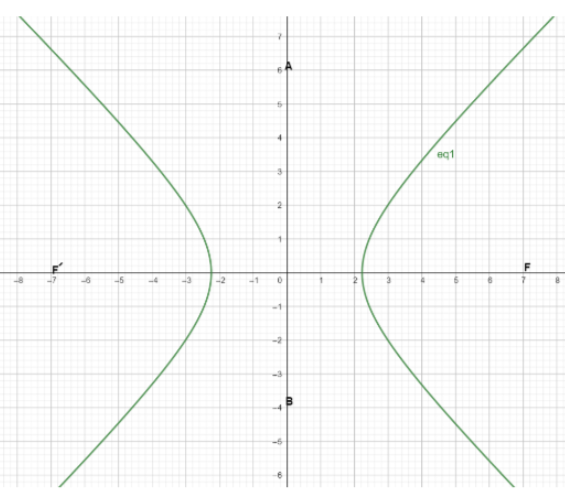
If a hyperbola has a length of its conjugate axis equal to 5 and the distance between its foci is 13, then the eccentricity of the hyperbola is:
(a).2
(b).
(c).
(d).
Answer
496.8k+ views
Hint: First of all, we will use the standard notation to denote the length of the conjugate axis, eccentricity, transverse axis.
Our approach is to first, we will calculate the length of the transverse axis, using the length between two foci and then we calculate then eccentricity of the hyperbola.
Length of transverse axis:2a
Length of conjugate axis:2b
Eccentricity: e.
The length between the two foci:2ae.
Complete step-by-step solution:
Next, we formulate two equations from the given information.

Here F and F’ are two foci, AB is a conjugate axis.
Next we know that,
Put the value of
From (2) & (3) we got the values of “
Hence, option (D) is correct.
We are done.
Note: First thing that you have to keep in mind the formula for the eccentricity, as if you are unable to memorize the formula, then it is going to be very tedious to prove the formula and then use it.
The next point to note is the in equation (1), when we substitute the value of “b”, in order to get “a”, we can also substitute the value of “a” in terms of “e” and find directly get the value of eccentricity.
Our approach is to first, we will calculate the length of the transverse axis, using the length between two foci and then we calculate then eccentricity of the hyperbola.
Length of transverse axis:2a
Length of conjugate axis:2b
Eccentricity: e.
The length between the two foci:2ae.
Complete step-by-step solution:
Next, we formulate two equations from the given information.

Here F and F’ are two foci, AB is a conjugate axis.
Next we know that,
Put the value of
From (2) & (3) we got the values of “
Hence, option (D) is correct.
We are done.
Note: First thing that you have to keep in mind the formula for the eccentricity, as if you are unable to memorize the formula, then it is going to be very tedious to prove the formula and then use it.
The next point to note is the in equation (1), when we substitute the value of “b”, in order to get “a”, we can also substitute the value of “a” in terms of “e” and find directly get the value of eccentricity.
Recently Updated Pages
Master Class 11 Economics: Engaging Questions & Answers for Success

Master Class 11 Business Studies: Engaging Questions & Answers for Success

Master Class 11 Accountancy: Engaging Questions & Answers for Success

Master Class 11 English: Engaging Questions & Answers for Success

Master Class 11 Computer Science: Engaging Questions & Answers for Success

Master Class 11 Maths: Engaging Questions & Answers for Success

Trending doubts
State and prove Bernoullis theorem class 11 physics CBSE

What are Quantum numbers Explain the quantum number class 11 chemistry CBSE

Write the differences between monocot plants and dicot class 11 biology CBSE

Why is steel more elastic than rubber class 11 physics CBSE

Explain why a There is no atmosphere on the moon b class 11 physics CBSE

1 ton equals to A 100 kg B 1000 kg C 10 kg D 10000 class 11 physics CBSE




